Java User Input
In the Java program, there are 3 ways we can read input from the user in the command line environment to get user input, Java BufferedReader Class, Java Scanner Class, and Console class. Let us discuss the classes in detail. We use the Scanner class to obtain user input. This program asks the user to enter an integer, a string, and float, and it will be printed on display. The scanner class in java.util is present so that we can add this package to our software. First, we create a Scanner Class object and use the Scanner Class method.
3 Ways of Java User Input
There are three ways to read the User Input:
ADVERTISEMENT Popular Course in this category JAVA MASTERY - Specialization | 78 Course Series | 15 Mock TestsStart Your Free Software Development Course
Web development, programming languages, Software testing & others
- Java BufferedReader Class
- Java Scanner Class
- Using console Class
These three class are mentioned below; let us discuss them in detail:
1. Java BufferedReader Class
It extends reader class. BufferedReader reads input from the character-input stream and buffers characters so as to provide an efficient reading of all the inputs. The default size is large for buffering. When the user makes any request to read, the corresponding request goes to the reader, and it makes a read request of the character or byte streams; thus, BufferedReader class is wrapped around another input streams such as FileReader or InputStreamReaders.
For example:
BufferedReader reader = new BufferedReader(new FileReader("foo.in"));BufferedReader can read data line by line using the method readLine() method.
BufferedReader can make the performance of code faster.
Constructors
BufferedReader has two constructors as follows:
1. BufferedReader(Reader reader): Used to create a buffered input character stream that uses the default size of an input buffer.
2. BufferedReader(Reader reader, input size): Used to create a buffered input character stream that uses the size provided for an input buffer.
Functions
- int read: It is used for reading a single character.
- int read(char[] cbuffer, int offset, int length): It is used for reading characters in the specified part of an array.
- String readLine (): Used to reading input line by line.
- boolean ready(): Used to test whether the input buffer is ready to read.
- long skip: Used for skipping the characters.
- void close(): It closes the input stream buffer and system resources associated with the stream.
When the user enters the character from the keyboard, it gets read by the device buffer and then from System.in it passes on to the buffered reader or input stream reader and gets stored in the input buffer.
Code:
import java.util.*;
import java.lang.*;
import java.io.*;
import java.io.BufferedReader;
import java.io.IOException;
import java.io.InputStreamReader;
/*package whatever //do not write package name here */
class BufferedReaderDemo {
public static void main (String[] args) throws NumberFormatException, IOException {
System.out.println("Enter your number");
BufferedReader br = new BufferedReader(new InputStreamReader(System.in));
int t = Integer.parseInt(br.readLine());
System.out.println("Number you entered is: " + t);
System.out.println("Enter your string");
String s = br.readLine();
System.out.println("String you entered is: " + s);
}
}Output:

Program with reading from InputStreamReader and BufferedReader:
import java.io.BufferedReader;
import java.io.IOException;
import java.io.InputStreamReader;
public class BufferedReaderDemo {
public static void main(String args[]) throws IOException{
InputStreamReader reader = new InputStreamReader(System.in);
BufferedReader br = new BufferedReader(reader);
System.out.println("What is your name?");
String name=br.readLine();
System.out.println("Welcome "+name);
}
}Output:

2. Java Scanner Class
java.util. scanner class is one of the classes used to read user input from the keyboard. It is available at the util package. Scanner classes break the user input using a delimiter that is mostly whitespaces by default. The scanner has many methods to read console input of many primitive types such as double, int, float, long, Boolean, short, byte, etc. It is the simplest way to get input in java. Scanner class implements Iterator and Closeable interfaces. The scanner provides nextInt() and many primitive type methods to read inputs of primitive types. The next() method is used for string inputs.
Constructors
- Scanner(File source): It constructs a scanner to read from a specified file.
- Scanner(File source, String charsetName): It constructs a scanner to read from a specified file.
- Scanner(InputStream source), Scanner(InputStream source, String charsetName): It constructs a scanner to read from a specified input stream.
- Scanner(0Readable source): It constructs a scanner to read from a specified readable source.
- Scanner(String source): It constructs a scanner to read from a specified string source.
- Scanner(ReadableByteChannel source): It constructs a scanner to read from a specified channel source.
- Scanner(ReadableByteChannel source, String charsetName): It constructs a scanner to read from a specified channel source.
Functions
Below are mentioned the method to scan the primitive types from console input through Scanner class.
- nextInt(),
- nextFloat(),
- nectDouble(),
- nextLong(),
- nextShort(),
- nextBoolean(),
- nextDouble(),
- nextByte(),
Program to read from Scanner Class:
Using scanner class.
import java.util.Scanner;
/*package whatever //do not write package name here */
class ScannerDemo {
public static void main (String[] args) {
Scanner sc = new Scanner(System.in);
System.out.println("Enter your number");
int t = sc.nextInt();
System.out.println("Number you entered is: " + t);
System.out.println("Enter your string");
String s = sc.next();
System.out.println("String you entered is: " + s);
}
}Output:

3. Using console Class
Using the console class to read the input from the command-line interface. It does not work on IDE.
Code:
public class Main
{
public static void main(String[] args)
{
// Using Console to input data from user
System.out.println("Enter your data");
String name = System.console().readLine();
System.out.println("You entered: "+name);
}
}Output:

The above is the detailed content of Java User Input. For more information, please follow other related articles on the PHP Chinese website!

Hot AI Tools

Undresser.AI Undress
AI-powered app for creating realistic nude photos

AI Clothes Remover
Online AI tool for removing clothes from photos.

Undress AI Tool
Undress images for free

Clothoff.io
AI clothes remover

AI Hentai Generator
Generate AI Hentai for free.

Hot Article

Hot Tools

Notepad++7.3.1
Easy-to-use and free code editor

SublimeText3 Chinese version
Chinese version, very easy to use

Zend Studio 13.0.1
Powerful PHP integrated development environment

Dreamweaver CS6
Visual web development tools

SublimeText3 Mac version
God-level code editing software (SublimeText3)

Hot Topics
 1377
1377
 52
52
 Perfect Number in Java
Aug 30, 2024 pm 04:28 PM
Perfect Number in Java
Aug 30, 2024 pm 04:28 PM
Guide to Perfect Number in Java. Here we discuss the Definition, How to check Perfect number in Java?, examples with code implementation.
 Random Number Generator in Java
Aug 30, 2024 pm 04:27 PM
Random Number Generator in Java
Aug 30, 2024 pm 04:27 PM
Guide to Random Number Generator in Java. Here we discuss Functions in Java with examples and two different Generators with ther examples.
 Weka in Java
Aug 30, 2024 pm 04:28 PM
Weka in Java
Aug 30, 2024 pm 04:28 PM
Guide to Weka in Java. Here we discuss the Introduction, how to use weka java, the type of platform, and advantages with examples.
 Smith Number in Java
Aug 30, 2024 pm 04:28 PM
Smith Number in Java
Aug 30, 2024 pm 04:28 PM
Guide to Smith Number in Java. Here we discuss the Definition, How to check smith number in Java? example with code implementation.
 Java Spring Interview Questions
Aug 30, 2024 pm 04:29 PM
Java Spring Interview Questions
Aug 30, 2024 pm 04:29 PM
In this article, we have kept the most asked Java Spring Interview Questions with their detailed answers. So that you can crack the interview.
 Break or return from Java 8 stream forEach?
Feb 07, 2025 pm 12:09 PM
Break or return from Java 8 stream forEach?
Feb 07, 2025 pm 12:09 PM
Java 8 introduces the Stream API, providing a powerful and expressive way to process data collections. However, a common question when using Stream is: How to break or return from a forEach operation? Traditional loops allow for early interruption or return, but Stream's forEach method does not directly support this method. This article will explain the reasons and explore alternative methods for implementing premature termination in Stream processing systems. Further reading: Java Stream API improvements Understand Stream forEach The forEach method is a terminal operation that performs one operation on each element in the Stream. Its design intention is
 TimeStamp to Date in Java
Aug 30, 2024 pm 04:28 PM
TimeStamp to Date in Java
Aug 30, 2024 pm 04:28 PM
Guide to TimeStamp to Date in Java. Here we also discuss the introduction and how to convert timestamp to date in java along with examples.
 Create the Future: Java Programming for Absolute Beginners
Oct 13, 2024 pm 01:32 PM
Create the Future: Java Programming for Absolute Beginners
Oct 13, 2024 pm 01:32 PM
Java is a popular programming language that can be learned by both beginners and experienced developers. This tutorial starts with basic concepts and progresses through advanced topics. After installing the Java Development Kit, you can practice programming by creating a simple "Hello, World!" program. After you understand the code, use the command prompt to compile and run the program, and "Hello, World!" will be output on the console. Learning Java starts your programming journey, and as your mastery deepens, you can create more complex applications.




